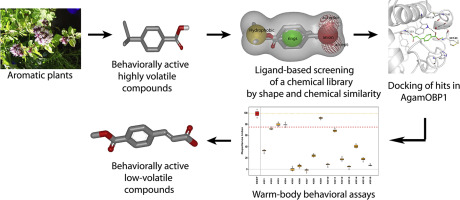Insect Biochemistry and Molecular Biology ( IF 3.2 ) Pub Date : 2018-05-08 , DOI: 10.1016/j.ibmb.2018.05.001 Trias Thireou , Georgia Kythreoti , Katerina E. Tsitsanou , Konstantinos Koussis , Christina E. Drakou , Julie Kinnersley , Thomas Kröber , Patrick M. Guerin , Jing-Jiang Zhou , Kostas Iatrou , Elias Eliopoulos , Spyros E. Zographos

|
In this work we report a fast and efficient virtual screening protocol for discovery of novel bioinspired synthetic mosquito repellents with lower volatility and, in all likelihood, increased protection time as compared with their plant-derived parental compounds. Our screening protocol comprises two filtering steps. The first filter is based on the shape and chemical similarity to known plant-derived repellents, whereas the second filter is based on the predicted similarity of the ligand's binding mode to the Anopheles gambiae odorant binding protein (AgamOBP1) relative to that of DEET and Icaridin to the same OBP. Using this protocol, a chemical library containing 42,755 synthetic molecules was screened in silico and sixteen selected compounds were tested for their affinity to AgamOBP1 in vitro and repellence against A. gambiae female mosquitoes using a warm-body repellent assay. One of them showed DEET-like repellence (91%) but with significantly lower volatility (2.84 × 10−6 mmHg) than either DEET (1.35 × 10−3 mmHg) or its parental cuminic acid (3.08 × 10−3 mmHg), and four other compounds were found to exhibit repellent indices between 69 and 79%. Overall, a correlation was not evident between repellence and OBP-binding strength. In contrast, a correlation between binding mode and repellence was found.
中文翻译:

通过基于配体的筛选和基于OBP结构的分子对接的组合,鉴定新型生物启发性的合成驱蚊剂
在这项工作中,我们报告了一种快速有效的虚拟筛选方案,用于发现与植物来源的亲本化合物相比具有较低挥发性的新型生物启发性合成驱蚊剂,并且极有可能增加了保护时间。我们的筛选方案包括两个过滤步骤。第一个过滤器基于与已知植物来源驱避剂的形状和化学相似性,而第二个过滤器基于配体与冈比亚按蚊气味结合蛋白(AgamOBP1)相对于DEET和叶黄素的预测相似性。到同一OBP。使用此协议,在计算机上筛选了包含42,755个合成分子的化学文库并使用温暖体驱除法测试了16种选定的化合物在体外对AgamOBP1的亲和力以及对冈比亚按蚊的雌性蚊子的驱避性。其中之一显示出与DEET相似的驱避性(91%),但其挥发性(2.84×10 -6 mmHg)明显低于DEET(1.35×10 -3 mmHg)或其亲本孜然酸(3.08×10 -3 mmHg),发现其他四种化合物的驱避指数在69%至79%之间。总体而言,在排斥性和OBP结合强度之间没有明显的相关性。相反,发现结合模式和排斥性之间的相关性。













































 京公网安备 11010802027423号
京公网安备 11010802027423号